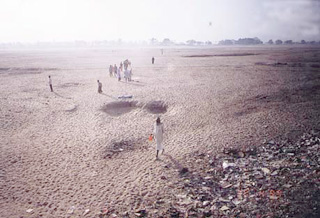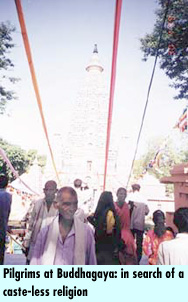 |

16th May 1999 |
News/Comment| Editorial/Opinion| Business| Sports | Mirror Magazine |
Hard trek to solaceBy Tharuka DissanaikeA normally serene Buddhagaya was teeming. Even the soaring temperatures of a bad heat wave had not deterred the masses gathered at this holiest of Buddhist shrines on the full moon day of April.They were celebrating the Indian equivalent of Vesak - the Buddha Mahotsav- and where better than at the very place where Lord Buddha attained enlightenment. The Gaya railway station, 16 kilometres away, was spilling over with
people, mostly elderly men and women in large groups escorted by saffron-robed
priests.All of them were carrying the five coloured The over-crowded trains carried but a few of the faithful. Many would make the arduous journey to Buddhagaya on foot, a few in crowded local buses. There was a time in India when Buddhism practically died out. But again in a strange repetition of history, many people are turning to the caste-less religion for solace from the heavily structured Indian society. Many of the new converts are 'low-caste' people from the state of Maharashtra. Their faith in Hinduism is not totally diminished though. Most quite comfortably incorporate the two religions, worshipping at the main Buddhagaya temple as well as the ancient Vishnupad temple closeby. Many Hindus themselves worshipped at Buddhist temples, considering Lord Buddha to be an incarnation of the Great God Vishnu. Judging from the people and their priests, the religion and its high philosophy were still new to them, but their devotion made up for any lack of fervour. For days they were camped outside the ancient high-domed temple at Buddhagaya, sleeping, eating and even washing and changing on the dusty streets- priests and lay people together. To find the shade of a rare tree would indeed be a blessing, especially as scorching daytime temperatures rose to 46-47 degrees Celsius. It surprised us to see young Indian Buddhist monks shaving and dressing on the streets quite at home among the hordes of people similarly camped out. Nearby the river Neranjana, presently called Phalgu, is without a drop
of water. The bridge across it looks incongruous, as pilgrims trek across
the wide sandy expanse to the place where Lord Buddha was offered milk
rice by a thankful Sujata, who believed him to be a tree-god. It was the
enlightened Buddha's first meal and a small temple denotes the place. The
walk is especially interesting as it There were no lanterns or pandals here. The only decor being long strips of cloth in Buddhist colours decorating the base of the temple all around it. The bo-tree behind and the Vajrasanaya denoting the place where Lord Buddha attained enlightenment, were especially heavily decorated. To add to the heat and the lack of water, even the electricity supply
was uncertain with long power failures and flickering low voltage. But
spirits could not be dampened. Lively chatter and music went on till late
night on the road outside the Mahabodhi Society, where Sri Lankan pilgrims
are provided with lodging. The raucous calling of vendors selling stone
Buddha statues, braswall hangings and glass Inside the temple, is a large statue of the seated Buddha. Originally done in stone the statue has been gilded and coloured subsequently. A number of East Asian countries have their own pilgrim houses and many are worth a visit. Especially noteworthy are the colourful Tibetan monastery and the 80-feet high Buddha standing on a lotus flower erected by the Japanese. Some six kilometres away are the caves where Lord Buddha spent his ascetic
life before he attained Nirvana. The journey is a combination of a drive
and about an hour's trek.
|
||
 |
Front Page| News/Comment| Editorial/Opinion| Business| Sports | Mirror Magazine |
|
 |
|
|
 Buddhist
flag, a few necessities bundled into a sack and cooking utensils.
Buddhist
flag, a few necessities bundled into a sack and cooking utensils.
 weaves
through a typical village with maize fields and grazing cattle and goats.
weaves
through a typical village with maize fields and grazing cattle and goats.
 bangles
rose above the chatter.
bangles
rose above the chatter.